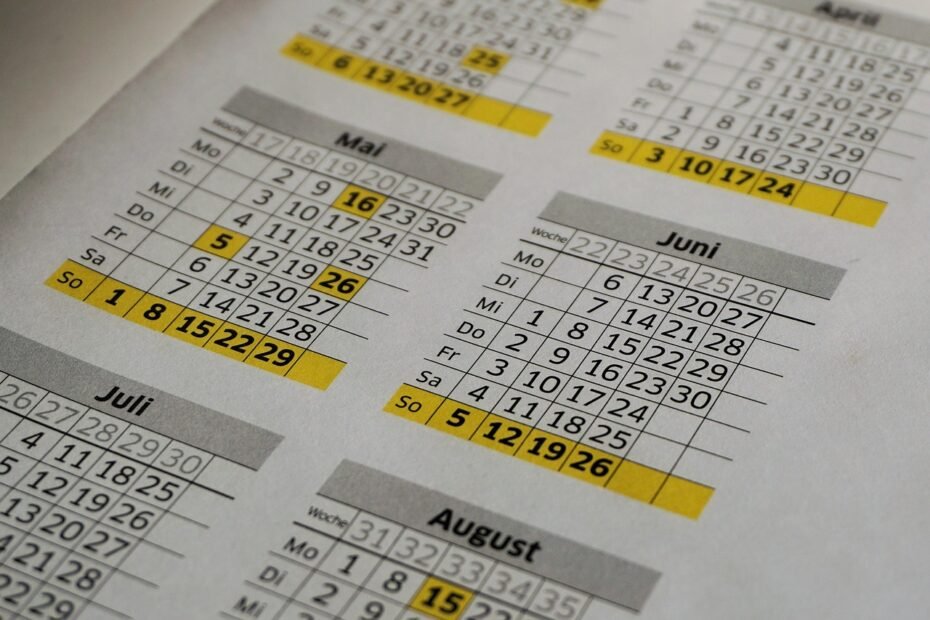We all have moments when we need to know exactly how many work days there are between two dates, maybe for a project schedule, leave planning, or computing pay on a contract. You can think, “I will just subtract and ignore weekends,” but a few unexpected holidays or calendar quirks can ruin even the best thought-out plan.
In this article, I will walk you through how to think about it simply, with real-life tips and the occasional pitfalls to steer clear of.
- 1. Why This Question Matters
- 2. The Basic Idea (and the One Pitfall You Can’t Ignore)
- 3. Step by Step: A Real Example
- 4. Using Spreadsheet Tools (Excel, Google Sheets) to Help
- 5. Handling Edge Cases That Trip People Up
- 5.1. 1. Start or end falls on a weekend
- 5.2. 2. Holidays outside the project range
- 5.3. 3. Custom weekend definitions
- 5.4. 4. Multiple non-continuous periods
- 5.5. 5. Leap years or crossing year boundaries
- 6. Hands-On Tips for Better Accuracy
- 7. Why This Matters in Real Life
- 8. FAQs About Calculating Working Days Between Two Dates
- 8.1. 1. What counts as a “working day”?
- 8.2. 2. How do I include holidays in the calculation?
- 8.3. 3. Can I calculate working days without Excel?
- 8.4. 4. Why do my results differ from other people’s?
- 8.5. 5. Is there a universal standard for working days?
Why This Question Matters
Let’s say you have a small team. You pledge to your client a deliverable in 30 workdays. Relying on “30 calendar days minus weekends” as a planning method can mislead you, overlook public holidays, or miscount when the start or end date is a weekend day. That will cost you money, time, or trust.
Or perhaps you’re the one asking for time off: you’d rather know, “If I request off from June 3 to June 28, how many business days am I requesting?” Having a standard approach avoids guessing.
Understanding working-day numbers also builds stronger discipline in your planning process. It makes you think about non-working days deliberately, so your deadlines are more realistic.
The Basic Idea (and the One Pitfall You Can’t Ignore)
At its simplest, the process is:
- Count all days between date A (start) and date B (end).
- Subtract weekends (typically Saturday and Sunday).
- Subtract any other non-working days (holidays, company-specific days off).
Easy enough, but the nuance is how you deal with start and end dates, and how you’re structuring “weekend” or “holiday” in your context. Are you including the first day if it’s a working day? Are you excluding a public holiday even if it falls outside your project timeline? These small boundary decisions have a noticeable effect.
For instance, if your starting date is a Monday and your ending date is the following Monday, going through “count all days → skip weekends” might give you 5 workdays or 6, depending on whether both Mondays are included. Clarity eliminates confusion.
Step by Step: A Real Example
Let’s say your project begins on Wednesday, August 4, 2026, and you must complete it by Tuesday, September 7, 2026. You want to find out how many working days you have.
- Count total days
From August 4 to September 7 inclusive is 35 days. - Subtract weekends
In those 35 days, there are 5 full weeks ( = 10 weekend days) and a few more days wherever they may lie. Minus weekends, maybe you’re left with 25 days. - Subtract holidays / non-working days
Suppose there’s a public holiday on August 15 and another on September 2. That takes away 2 more days. Net working days = 23.
If you weren’t watching whether to include or exclude the start or finish, you might get 22 or 24 instead. That’s enough to derail a plan.
Using Spreadsheet Tools (Excel, Google Sheets) to Help
You don’t need to do it by hand, spreadsheets are your friend. Excel (and Google Sheets) have automated functions to calculate the net working days automatically:
- In Excel: =NETWORKDAYS(start_date, end_date, [holidays]) disregards weekends by default and can disregard optional holiday dates.
- If your weekends aren’t Saturday + Sunday (you know, for example, that you work Sundays but not Fridays), Excel has NETWORKDAYS.INTL so that you can specify which days to treat as weekends.
- In Google Sheets, you also have the function NETWORKDAYS with the same arguments.
These functions are a lifesaver: you just enter your start, end, and list of holiday dates, and they return your working day number.
However, one caution: the built-in functions include both start and end dates if they are workdays. If you need to count “only full days between,” you might subtract 1 or make necessary adjustments.
Handling Edge Cases That Trip People Up
Here are a few tricky situations to watch out for (and how to deal with them):
1. Start or end falls on a weekend
If your start date is a Saturday, do you count it? Most people use it as “not a working day” and begin on Monday. The built-in function does that automatically, but if you are writing your own logic, don’t forget to move the start (or end) to the next working day.
2. Holidays outside the project range
Every now and then, a holiday list spans your range. If your logic or function subtracts all the holidays without restrictions, you will end up over-subtracting. Always limit holidays to only those within your start–end range.
3. Custom weekend definitions
In some workplaces, the “weekend” consists of Friday + Saturday, or just Sunday. Use the custom weekend option (NETWORKDAYS.INTL) or your own business logic to define which days are not working.
4. Multiple non-continuous periods
What if your work period is split (e.g., paused during summer, resumed later)? You’ll need to break into segments and sum the working days of each.
5. Leap years or crossing year boundaries
Crossing from December into January of a leap year can shift things. But since you’re counting per day and subtracting the defined non-working days, your logic will still hold, just be careful with holiday date definitions across years.
Hands-On Tips for Better Accuracy
- Always create a clean holiday list within your local calendar (company holidays, national holidays).
- When doing an estimate, add a 1–2 extra working-day buffer.
- If you’re applying this thinking to code (e.g., writing a project planner app), consider caching results or precomputing working-day calendars.
- For visual clarity, build a calendar grid and color weekends and holidays, seeing it helps catch mistakes.
- Use named ranges in spreadsheets (e.g. HolidayList) so your formula looks tidy:
=NETWORKDAYS(StartDate, EndDate, HolidayList) - When you want to visualize your results, turning them into a poster design can be a creative way to make those numbers easier for everyone to understand.
Why This Matters in Real Life
A small agency pledged a client delivery within “30 workdays.” They scheduled from March 1 to April 11, subtracting weekends (8 days) and landed on March 31 as per the records. But they overlooked holidays on March 17 and April 2, so the project had only 20 working days.
If they had added those holidays to their calculations in advance, their planning and communication would have been accurate. The same is true for individual planning, like vacation days, study schedules, or freelance billing cycles.
Having an easy method to calculate workdays gives you clarity when you are planning your calendar, your team, or even your next inspiration poster creation for the office wall.
FAQs About Calculating Working Days Between Two Dates
1. What counts as a “working day”?
A working day usually means Monday through Friday, excluding weekends and public holidays. However, the definition can vary depending on your country or company policy.
2. How do I include holidays in the calculation?
You can manually list all public holidays in your spreadsheet and add that list as the third argument in the NETWORKDAYS formula. This ensures those dates are automatically excluded from your working-day count.
3. Can I calculate working days without Excel?
Yes! You can use free online calculators or even write a small script in Python, JavaScript, or any programming language that loops through dates and skips weekends and holidays.
4. Why do my results differ from other people’s?
Differences often come from whether you include both the start and end dates or how you handle holidays. Always agree on those rules before comparing results.
5. Is there a universal standard for working days?
No, working days depend heavily on local labor laws and cultural norms. Some countries have a Friday–Saturday weekend instead of Saturday–Sunday, so always adjust your calculation accordingly.


